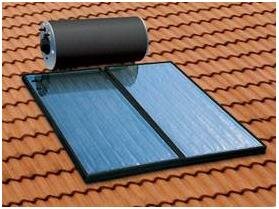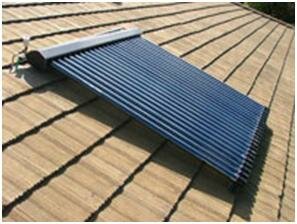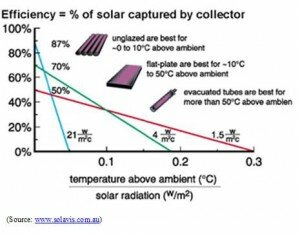Contrary to what the terminology suggests ‘solar thermal energy’ is not a recent development and it is certainly not something that has just been invented as another answer to reduce greenhouse emissions. According to the Renewable Institute for Sustainable Research, the first solar powered engines were constructed back in the 1860s by a couple of French mathematicians. During the past 30 years a number of solar thermal plants have been built and operated around the world to produce guilt-free electricity. However, the technology has been rapidly evolving in recent years and Australia has perfected the technology to make it commercially more viable.
Unlike wind power or solar photovoltaic panels, which generate electricity directly, solar thermal power uses mirrors to concentrate the sun’s energy onto a receiver and create heat, which can then be used to produce steam to run a turbine and generate electricity, in the same way as a conventional coal-fired power station. The other advantage of solar thermal technology is that it can be stored very efficiently in large tanks of molten salt and then be dispatched to generate electricity at any time of the day or night, making it in effect base load solar power.
The way solar thermal energy plants work is by focusing the glare of the sun’s rays on a central location –usually on a tall solar tower- to create heat, which is then turned into electricity. The concentrated heat is extreme between 500-2000 C and it could easily melt metal. Due to various heat exchange processes involved –which were further advanced in Australia- the water eventually turns to steam, powering the turbines at the base.
Various methods exist to concentrate the solar radiation, including parabolic troughs, power towers with mirrors that track the sun (heliostats), parabolic dishes, and Fresnel reflectors (these consist of multiple flat mirrors). Each technology differs in the way that it concentrates the solar energy, but they all track the sun to maximise energy capture and produce heat, which is then converted to electricity.
These technologies are at different stages of development and each has its own advantages and disadvantages. It is fair to say that parabolic troughs are the most mature, having first been installed at utility scale in the 1980s; although the other types may ultimately prove cheaper due to their inherent design advantages. These technologies have been successfully used in the USA and Spain since the 1980s. But the Australian National University has re-designed the dish for optimisation for manufacturing and mass production with mirror panels that should be able to concentrate the sun at least 2,000 times.
Solar Thermal Uptake in Australia
Australia has large areas of high solar intensity and little rain, where large concentrations of renewable energy power stations could be developed. In fact the Australian continent has the highest average amount of solar radiation per square meter per year of any continent on the planet ranging from 1500 to 1900 kWh/m2/year. In other words Australia is better-suited to this technology than any other country in the world, including Spain who is expecting to operate 60 solar thermal plants by 2013.
Peter Meurs (Managing Director of WorleyParsons-EcoNomics) has said that establishing advanced solar thermal centres could allow Australia to exceed the 20 per cent renewable energy target by:
• Facilitating the commercialisation of developing renewable energy technologies.
• Triggering the development of domestic solar thermal component manufacturing.
• Enabling Australia to become a world leader in these technologies.
• Allowing the construction of larger scale solar thermal power stations over time.
Wizard Power is also part of the same consortium who has been trying to commercialise big dish technology in Australia for the past five years. Their unique technology was developed by the Australian National University’s solar thermal group over the past 40 years who have perfected ‘the big dish’ and they’ve also figured how to best store the sun’s energy thermo-chemically. It appears that Wizard Power may be getting some support from the federal government in the form of $60 million towards a $230 million solar plant it’s building in South Australia. Wizard Power suggested Whyalla in South Australia as an ideal place to establish large scale solar facilities, because of the climate and the number of large scale resource projects requiring power. Australia’s very first solar oasis in Whyalla is going to provide enough electricity to power the town of Whyalla and also to provide power to the neighbouring steel works. In total it’s capable of powering approximately 9000 average homes or replacing something in the order of 17000 motor vehicles on the road each year in terms of carbon emissions.
There is no reason why Australia couldn’t match the Spanish government’s commitment who is expecting to cover 12 percent of its primary energy from renewable sources by the end of this year. Spain is the fourth largest manufacturer in the world of solar power technology and exports 80 percent of its production to Germany. Australia cannot quite export electricity to other countries but we could export our expertise in this technology to build solar thermal plants in other countries. At the same time there is no reason why 30 solar thermal plants could not provide 40 per cent of Australia’s renewable energy needs by 2020-according to WorleyParsons. But to achieve this goal, action must be taken today.
References:
http://www.npr.org/templates/story/story.php?storyId=13826548)
http://www.abc.net.au/insidebusiness/content/2010/s2925759.htm
http://ecogeneration.com.au/news/advancing_solar_thermal/002019/
http://ecolocalizer.com/2008/04/12/mega-solar-the-worlds-13-biggest-solar-thermal-energy-projects/
K. Lovergrove and M. Dennis Solar Thermal Energy Systems in Australia 2006 International Journal of Environmental Studies (www.tandf.co.uk/journals)





